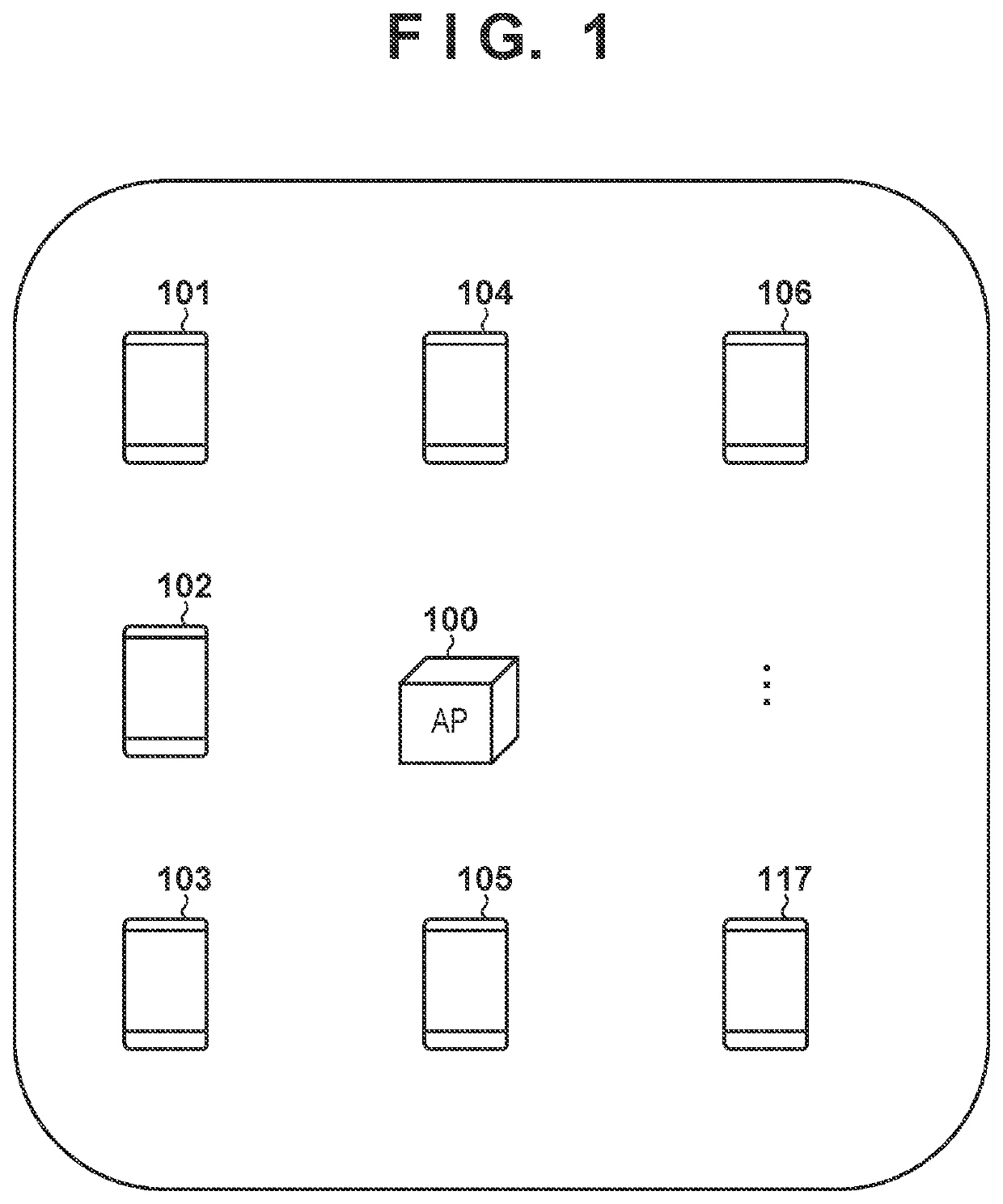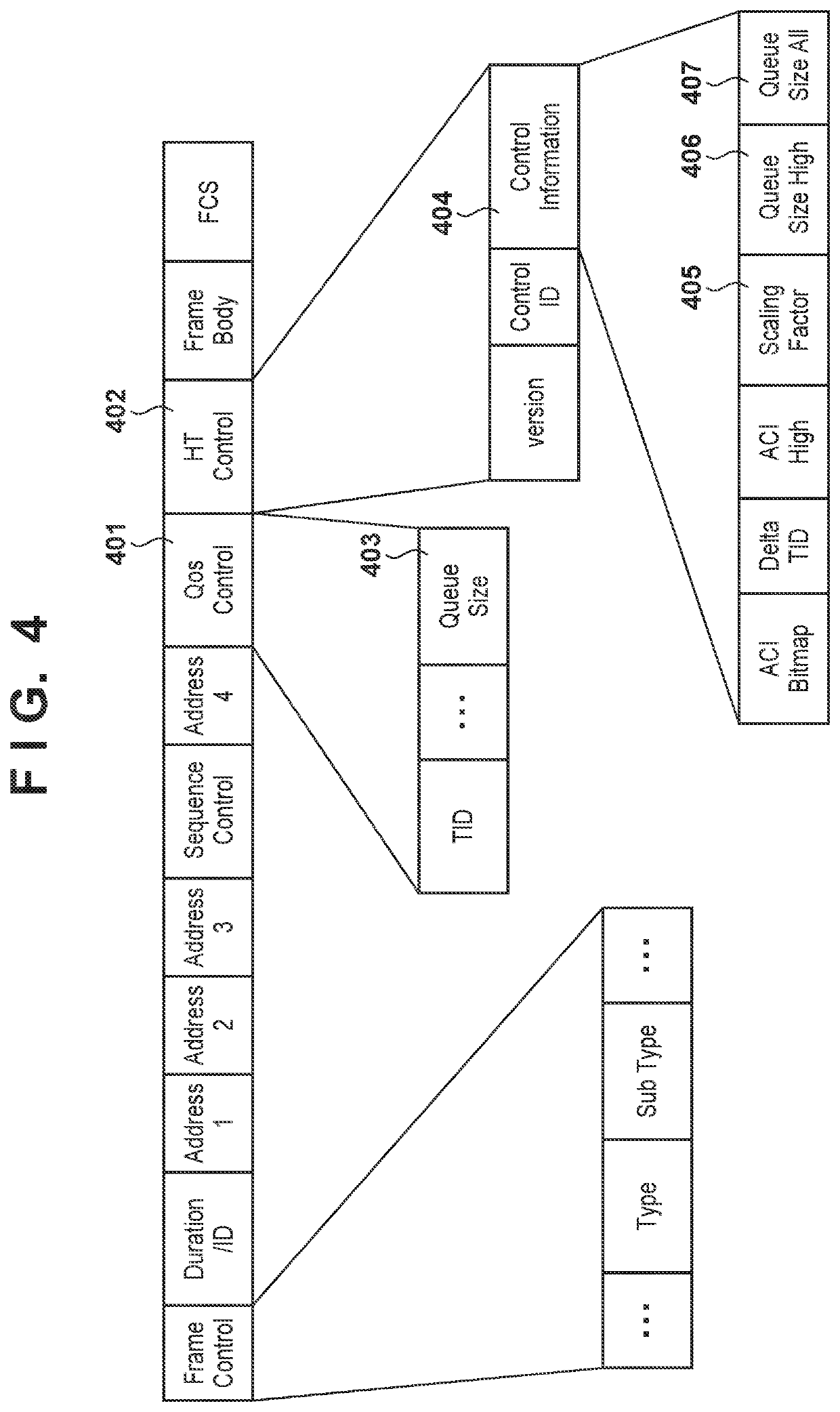Communication apparatus, communication method, and non-transitory computer-readable storage medium
a communication apparatus and computer-readable storage technology, applied in the direction of digital transmission, payload allocation, transmission path sub-channel allocation, etc., can solve the problems of poor frequency utilization efficiency, large data padding of stas having a small amount of data, and waste of communication bandwidth, so as to improve the frequency utilization efficiency of wireless communication
- Summary
- Abstract
- Description
- Claims
- Application Information
AI Technical Summary
Benefits of technology
Problems solved by technology
Method used
Image
Examples
first embodiment
[0029]FIG. 1 illustrates a configuration example of a network according to a first embodiment. FIG. 1 illustrates a configuration including 17 STAs 101 to 117 that support IEEE 802.11ax and one AP 100. Signals transmitted by the AP 100 can be received in the STAs 101 to 117. It is assumed that the STAs 101 to 117 and the AP 100 have been authenticated and can transmit and receive data to and from each other. However, this is merely one example, and the following discussion can be applied, for example, to a network including a large number of STAs in a wide area, or to various positional relationships of STAs.
[0030]In the example of FIG. 1, the STAs 101 to 117 perform MU communication (multi-user communication) with the AP 100 through OFDMA. Communication is performed by DL (downlink)-OFDMA from the AP 100 to the STAs 101 to 117 and by UL-OFDMA from the STAs 101 to 117 to the AP 100. In the present embodiment, each of the STAs 101 to 117 holds data to be transmitted, and the AP is no...
second embodiment
[0056]Points in which the RU assignment processing for UL-OFDMA in the second embodiment differ from the RU assignment processing in the first embodiment will be described. FIG. 11 is a flow chart illustrating RU assignment processing for UL-OFDMA in the present embodiment. Since the processing of steps S1101 to S1112 is the same as the processing of steps S911 to step S922 of the FIG. 9B described in the first embodiment, the description thereof is omitted.
[0057]In step S1105, in a case where grouping of all STAs (data of all STAs) is completed (YES in step S1105), the process proceeds to step S1115. Based on the information of FIG. 7, the configurations of the UL-OFDM frames assumed at this point in time are the UL-OFDM frames 1001 and 1002 illustrated in FIG. 10. In step S1115, the grouping unit 305 determines whether the RU index is less than a maximum number of RUs N. In a case where the RU index is less than the maximum number of RUs (YES in step S1115), the process proceeds t...
third embodiment
[0059]Points in which the RU assignment processing for UL-OFDMA in the third embodiment differs from the RU assignment processing in the first and second embodiment will be described. FIG. 13 illustrates a second example of information of a transmission buffer amount, MCS, and communication time of each of the STAs 101 to 117 managed by the AP 100. In FIG. 13, compared with FIG. 7, the Queue size of an STA (STA 102) corresponding to AID2 is larger (=10), and a communication time of 20 ms is required (underlined portions).
[0060]FIG. 14 is a flow chart illustrating RU assignment processing for UL-OFDMA in the present embodiment. FIG. 15 illustrates a flow of communication frames for describing the present embodiment. Regarding FIG. 15, points different from FIG. 10 will be described.
[0061]In FIG. 14, since the processing of steps S1401 to S1412 is the same as the processing of steps S911 to step S922 of FIG. 9B described in the first embodiment, the description thereof is omitted. In ...
PUM
 Login to View More
Login to View More Abstract
Description
Claims
Application Information
 Login to View More
Login to View More - R&D
- Intellectual Property
- Life Sciences
- Materials
- Tech Scout
- Unparalleled Data Quality
- Higher Quality Content
- 60% Fewer Hallucinations
Browse by: Latest US Patents, China's latest patents, Technical Efficacy Thesaurus, Application Domain, Technology Topic, Popular Technical Reports.
© 2025 PatSnap. All rights reserved.Legal|Privacy policy|Modern Slavery Act Transparency Statement|Sitemap|About US| Contact US: help@patsnap.com



